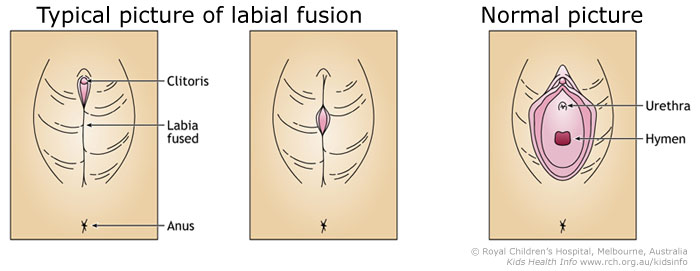Labial fusion
-
Labial fusion is common in young girls. It is the term used to describe the condition when the two sides of the labia stick or join together. The join (or fusion) will usually separate by itself by the time your daughter has her first period. Treatment is not usually needed or recommended because it can cause your daughter more pain and anxiety. There is also a risk that the fusion will return if any treatment occurs.
Signs and symptoms
The join in the labia is down the middle where you can see a thin, light streak. It is almost never present at birth, but more commonly develops between about one to two years of age.
Causes
Doctors are not sure what causes some girls to have labial fusion. It seems it may sometimes happen after an inflammation of the labial area. This may have been caused by a simple infection such as vulvovaginitis.

Treatment
The join (or fusion) usually separates naturally by the time your daughter has her first period. This happens slowly. There is no pain and she will not notice it happening. Medical treatment, massage or cream is not usually needed.
Medical treatment to pull apart the labia is not recommended, as there is a high risk that the adhesion or fusion will return. The procedure can be painful and your daughter might grow up worrying that there is something wrong with her. Leaving it alone is the safest and most effective treatment.
What to expect
Very occasionally a girl may get a urinary tract infection (UTI). This is not common and can usually be treated simply and effectively. If there is even a very small opening (one millimetre or more) there is enough space for the urine (wee) to drain.
There is no relationship at all between labial fusion and any other medical conditions. Labial fusion does not have any effect on future fertility. As an adult, your daughter will be able to have sex and be able to have children the same as other women.
Follow-up
Your local GP or family doctor can normally diagnose this condition. There is no need to see a specialist. As long as the fusion is not causing a problem it can be left alone until it disappears.
Key points to remember
- Labial fusion is common.
- It does not usually cause any other symptoms.
- It is not related to other problems.
- The fusion will normally separate naturally by the time your daughter has her first period.
- The safest, most effective and least stressful thing to do is no treatment.




 Superintendent, ICH.
Superintendent, ICH.